TOYOTA YARIS HATCHBACK 2020 Owners Manual (in English)
Manufacturer: TOYOTA, Model Year: 2020, Model line: YARIS HATCHBACK, Model: TOYOTA YARIS HATCHBACK 2020Pages: 572, PDF Size: 7.94 MB
Page 531 of 572
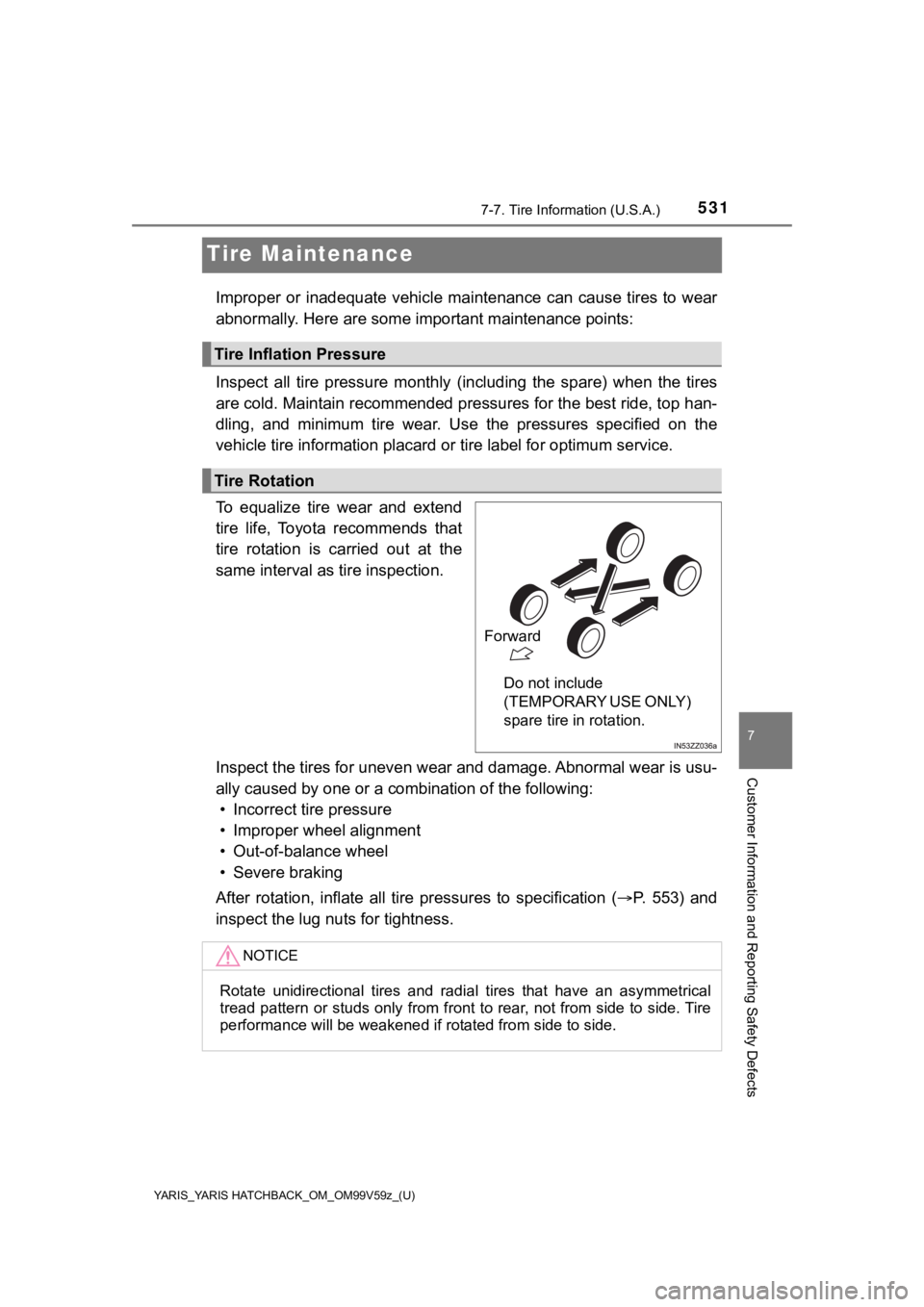
531
YARIS_YARIS HATCHBACK_OM_OM99V59z_(U)
7-7. Tire Information (U.S.A.)
7
Customer Information and Reporting Safety Defects
Tire Maintenance
Improper or inadequate vehicle maintenance can cause tires to w ear
abnormally. Here are some important maintenance points:
Inspect all tire pressure monthly (including the spare) when th e tires
are cold. Maintain recommended pressures for the best ride, top han-
dling, and minimum tire wear. Use the pressures specified on th e
vehicle tire information placard or tire label for optimum service.
To equalize tire wear and extend
tire life, Toyota recommends that
tire rotation is carried out at the
same interval as tire inspection.
Inspect the tires for uneven w ear and damage. Abnormal wear is usu-
ally caused by one or a combination of the following: • Incorrect tire pressure
• Improper wheel alignment
• Out-of-balance wheel
• Severe braking
After rotation, inflate all tire pressures to specification ( P. 553) and
inspect the lug nu ts for tightness.
Tire Inflation Pressure
Tire Rotation
Forward
Do not include
(TEMPORARY USE ONLY)
spare tire in rotation.
NOTICE
Rotate unidirectional tires and radial tires that have an asymm etrical
tread pattern or studs only from front to rear, not from side t o side. Tire
performance will be weak ened if rotated from side to side.
Page 532 of 572
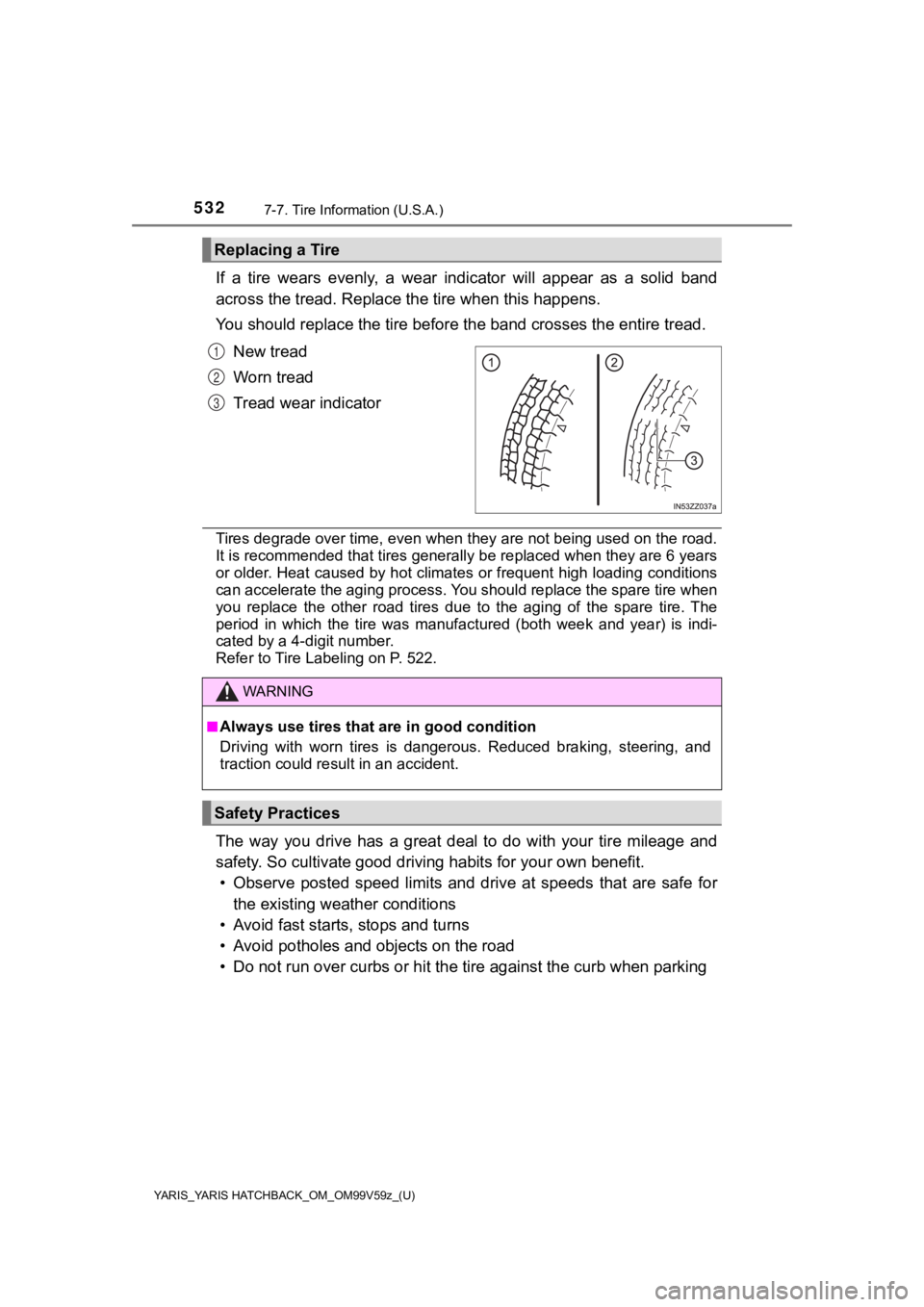
532
YARIS_YARIS HATCHBACK_OM_OM99V59z_(U)
7-7. Tire Information (U.S.A.)
If a tire wears evenly, a wear indicator will appear as a solid band
across the tread. Replace the tire when this happens.
You should replace the tire before the band crosses the entire tread.
New tread
Worn tread
Tread wear indicator
Tires degrade over time, even wh en they are not being used on the road.
It is recommended that tires gen erally be replaced when they are 6 years
or older. Heat caused by hot climates or frequent high loading conditions
can accelerate the aging process. You should replace the spare tire when
you replace the other road tires due to the aging of the spare tire. The
period in which the tire was manufactured (both week and year) is indi-
cated by a 4-digit number.
Refer to Tire Labeling on P. 522.
The way you drive has a great deal to do with your tire mileage and
safety. So cultivate good driving habits for your own benefit. • Observe posted speed limits and drive at speeds that are safe for
the existing weather conditions
• Avoid fast starts , stops and turns
• Avoid potholes and objects on the road
• Do not run over curbs or hit th e tire against the curb when pa rking
Replacing a Tire
1
2
3
WARNING
■Always use tires that are in good condition
Driving with worn tires is dangero us. Reduced braking, steering, and
traction could result in an accident.
Safety Practices
Page 533 of 572

YARIS_YARIS HATCHBACK_OM_OM99V59z_(U)
5337-7. Tire Information (U.S.A.)
7
Customer Information and Reporting Safety Defects
NOTICE
If you feel a sudden vibration or ride disturbance while drivin g or you
suspect your tire or vehicle has been damaged, immediately redu ce
your speed. Drive with caution until you can safely pull off th e road. Stop
and inspect the tire for damage. I f the tire is under-inflated or damaged,
deflate it, remove the tire and rim and replace it with your sp are tire. If
you cannot detect a cause, have the vehicle towed to the neares t vehi-
cle or tire dealer to have the vehicle inspected.
Page 534 of 572
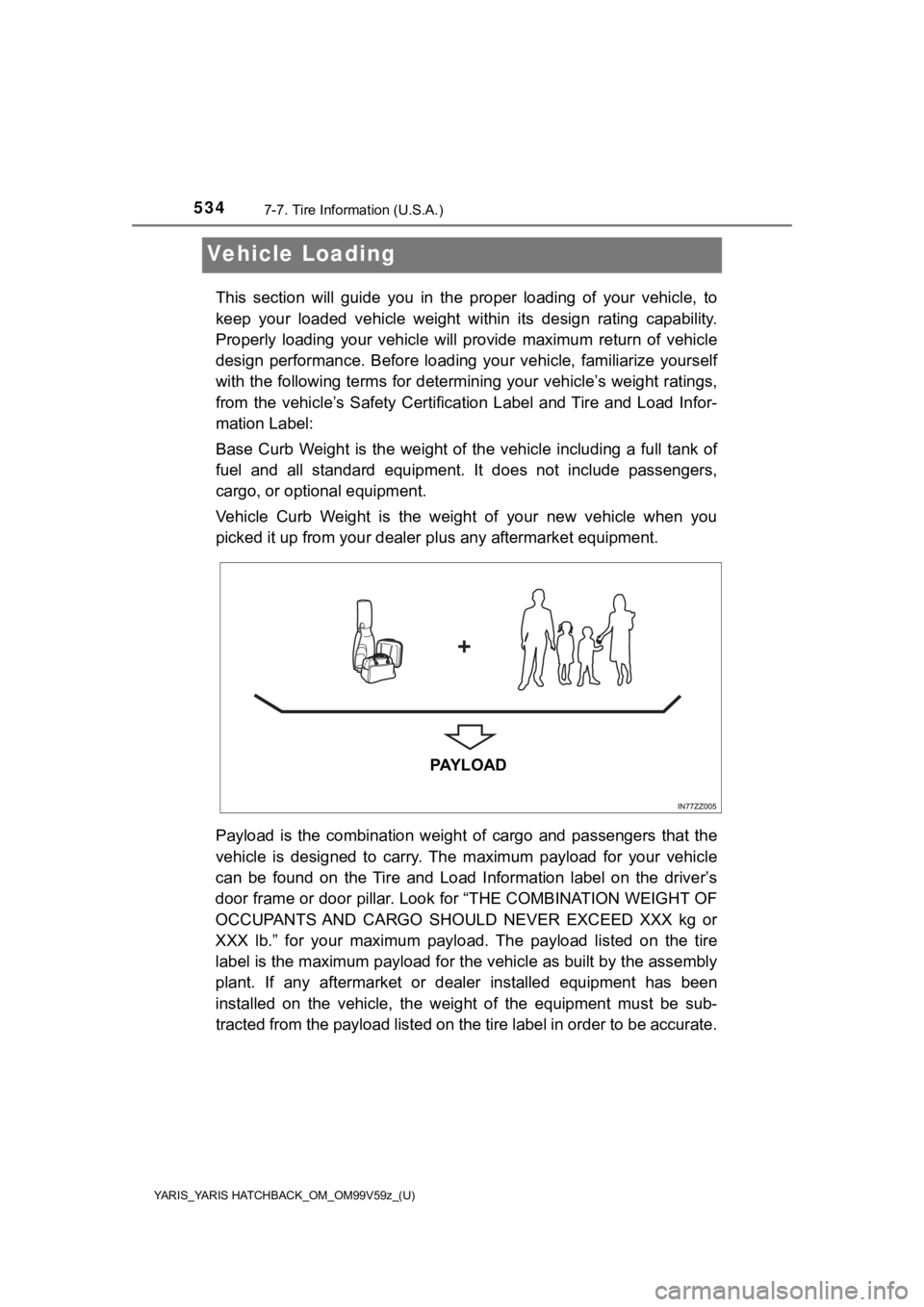
534
YARIS_YARIS HATCHBACK_OM_OM99V59z_(U)
7-7. Tire Information (U.S.A.)
Vehicle Loading
This section will guide you in the proper loading of your vehicle, to
keep your loaded vehicle weight within its design rating capabi lity.
Properly loading your vehicle w ill provide maximum return of ve hicle
design performance. Before load ing your vehicle, familiarize yourself
with the following terms for determining your vehicle’s weight ratings,
from the vehicle’s Safety Certification Label and Tire and Load Infor-
mation Label:
Base Curb Weight is the weight of the vehicle including a full tank of
fuel and all standard equipment. It does not include passengers,
cargo, or optional equipment.
Vehicle Curb Weight is the weight of your new vehicle when you
picked it up from your dealer p lus any aftermarket equipment.
Payload is the combination weight of cargo and passengers that the
vehicle is designed to carry. The maximum payload for your vehicle
can be found on the Tire and Load Information label on the driv er’s
door frame or door pillar. Look for “THE COMBINATION WEIGHT OF
OCCUPANTS AND CARGO SHOULD NEVER EXCEED XXX kg or
XXX lb.” for your maximum payload. The payload listed on the ti re
label is the maximum payload for the vehicle as built by the assembly
plant. If any aftermarket or dealer installed equipment has bee n
installed on the vehicle, the we ight of the equipment must be s ub-
tracted from the payload listed on the tire label in order to b e accurate.
PAY L O A D
Page 535 of 572
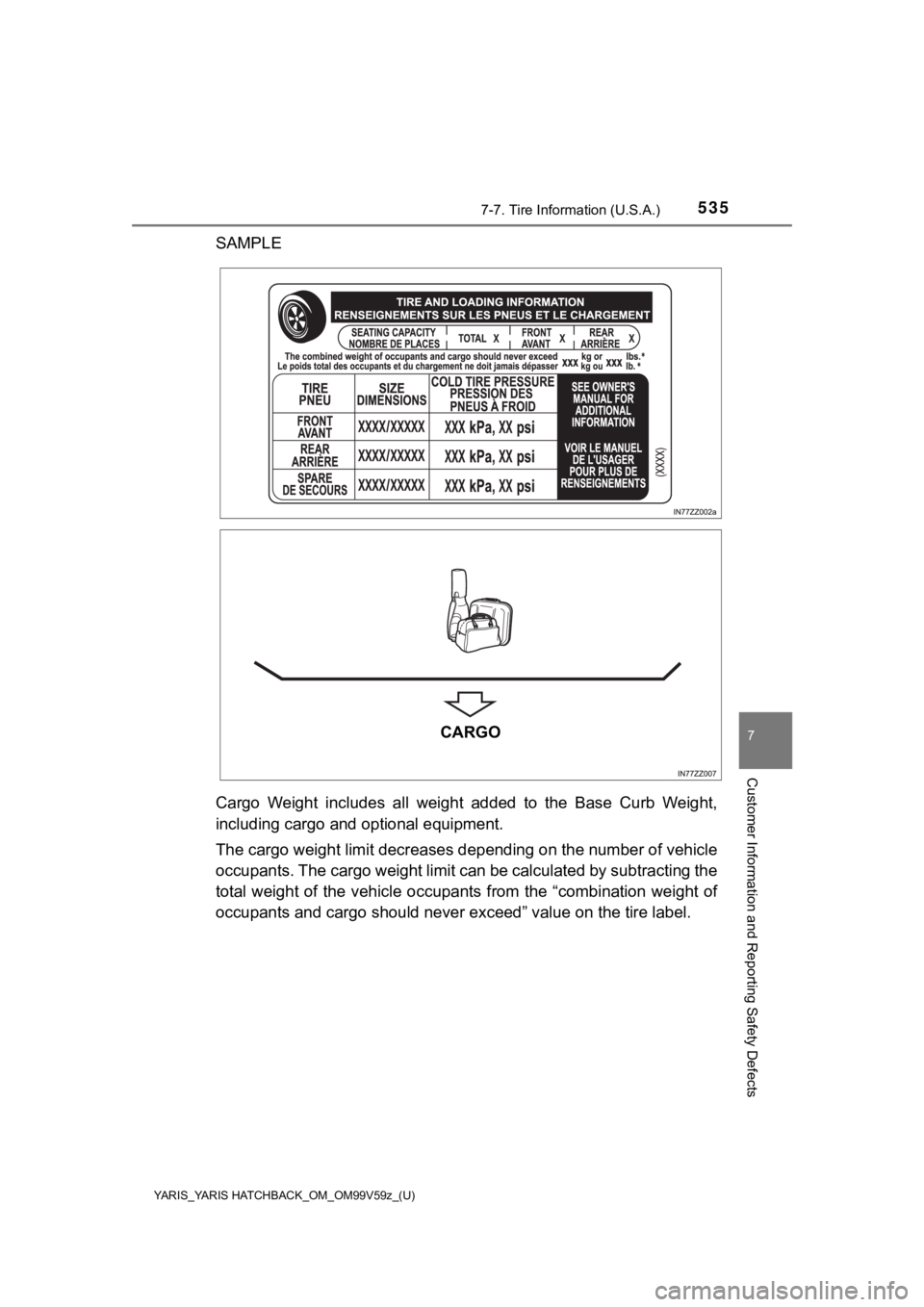
YARIS_YARIS HATCHBACK_OM_OM99V59z_(U)
5357-7. Tire Information (U.S.A.)
7
Customer Information and Reporting Safety Defects
SAMPLE
Cargo Weight includes all weight added to the Base Curb Weight,
including cargo and optional equipment.
The cargo weight lim it decreases depending on the number of veh icle
occupants. The cargo weight limit can be calculated by subtract ing the
total weight of the vehicle occ upants from the “combination wei ght of
occupants and cargo s hould never exceed” value on the tire labe l.
CARGO
Page 536 of 572
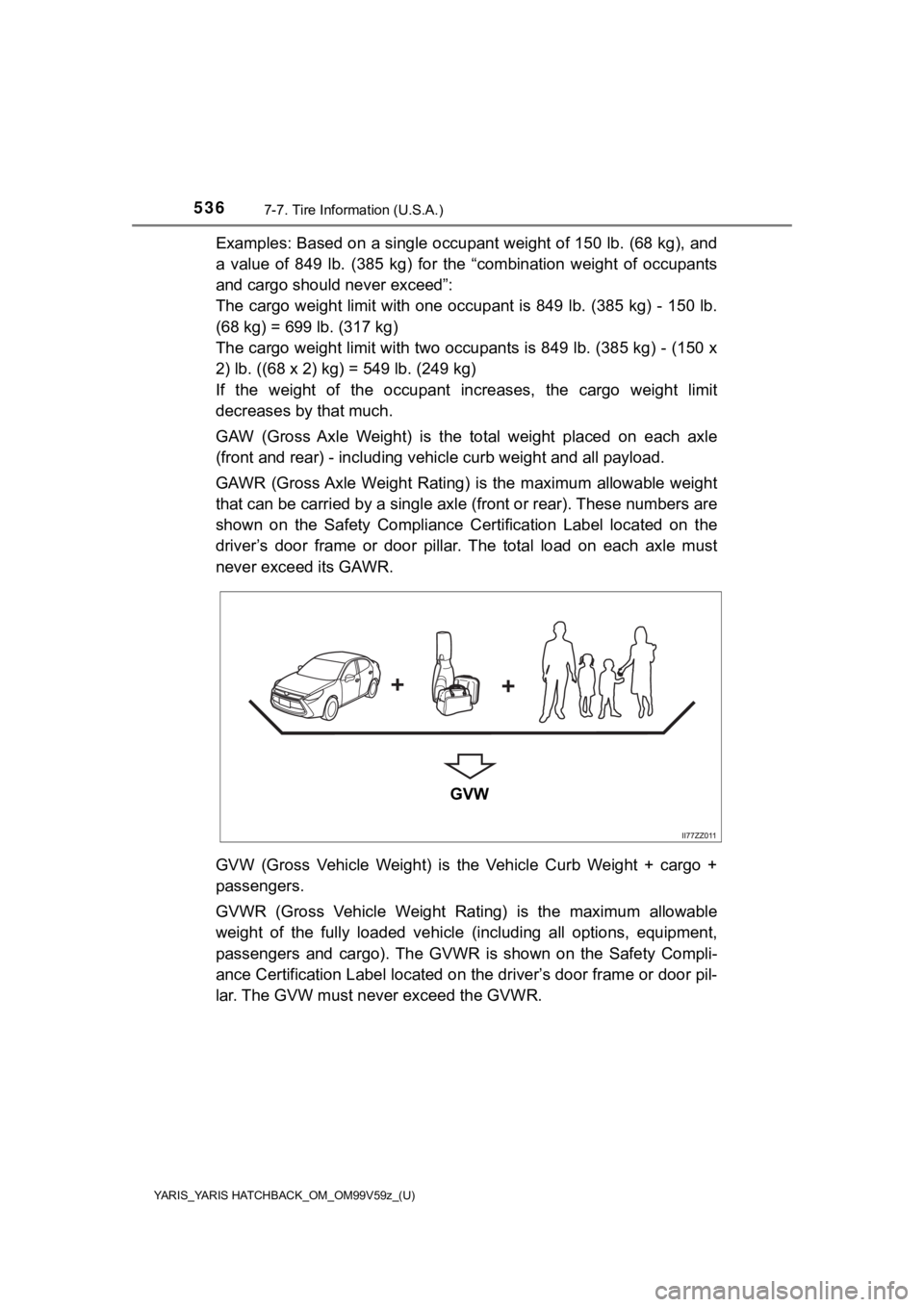
536
YARIS_YARIS HATCHBACK_OM_OM99V59z_(U)
7-7. Tire Information (U.S.A.)
Examples: Based on a single occupant weight of 150 lb. (68 kg), and
a value of 849 lb. (385 kg) for the “combination weight of occu pants
and cargo should never exceed”:
The cargo weight limit with one occupant is 849 lb. (385 kg) - 150 lb.
(68 kg) = 699 lb. (317 kg)
The cargo weight limit with two occupants is 849 lb. (385 kg) - (150 x
2) lb. ((68 x 2) kg) = 549 lb. (249 kg)
If the weight of the occupant inc reases, the cargo weight limit
decreases by that much.
GAW (Gross Axle Weight) is the total weight placed on each axle
(front and rear) - incl uding vehicle curb weight and all payloa d.
GAWR (Gross Axle Weight Rating) is the maximum allowable weight
that can be carried by a single axle (front or rear). These numbers are
shown on the Safety Compliance Ce rtification Label located on the
driver’s door frame or door p illar. The total load on each axle must
never exceed its GAWR.
GVW (Gross Vehicle Weight) is the Vehicle Curb Weight + cargo +
passengers.
GVWR (Gross Vehicle Weight Rating) is the maximum allowable
weight of the fully loaded vehicl e (including all options, equipment,
passengers and cargo). The GVWR is shown on the Safety Compli-
ance Certification Label located on the driver’s door frame or door pil-
lar. The GVW must never exceed the GVWR.
GVW
Page 537 of 572
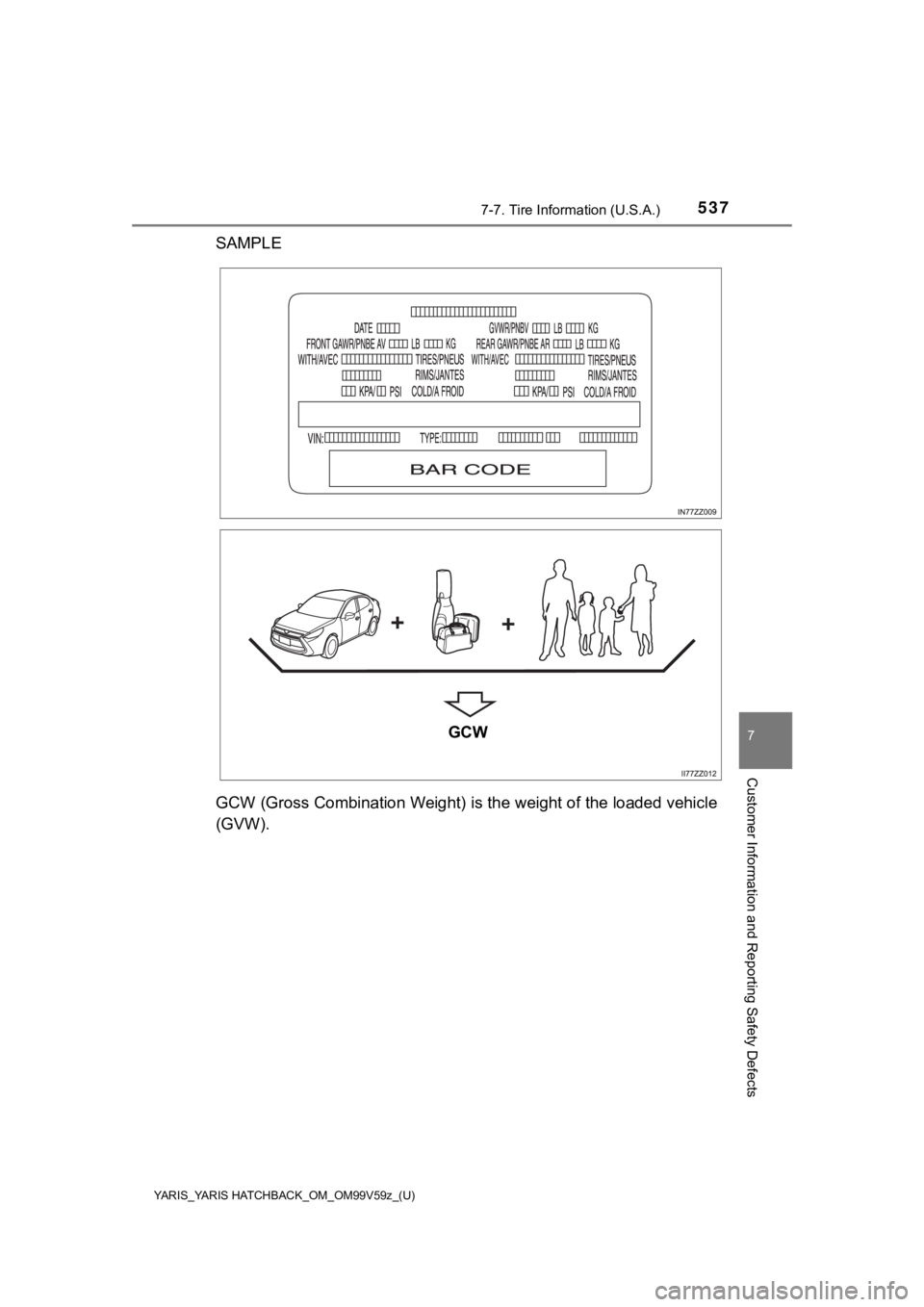
YARIS_YARIS HATCHBACK_OM_OM99V59z_(U)
5377-7. Tire Information (U.S.A.)
7
Customer Information and Reporting Safety Defects
SAMPLE
GCW (Gross Combination Weight) is the weight of the loaded vehicle
(GVW).
GCW
Page 538 of 572

538
YARIS_YARIS HATCHBACK_OM_OM99V59z_(U)
7-7. Tire Information (U.S.A.)
GCWR (Gross Combination Weight Rating) is the maximum allowable
weight of the vehicle - including all cargo and passengers - that the
vehicle can handle without risk ing damage. The GCW must never
exceed the GCWR.
WARNING
■Do not tow a trailer with this vehicle
Towing a trailer with this vehicle is dangerous because it has not been
designed to tow a trailer and do ing so will affect the drive system which
could result in vehicle damage.
■Overloaded Vehicle
Overloading a vehicle is dangerous. The results of overloading can
have serious consequences in terms of passenger safety. Too muc h
weight on a vehicle’s suspensi on system can cause spring or sho ck
absorber failure, brake failure, handling or steering problems, irregular
tire wear, tire failu re or other damage.
Overloading makes a vehicle harder to drive and control. It als o
increases the distance required for stopping. In cases of serio us over-
loading, brakes can fail completely, particularly on steep grad es. The
load a tire will carry safely is a combination of the size of t he tire, its load
range, and corresponding inflation pressure.
Never overload the vehicle and always observe the vehicle’s wei ght rat-
ings from the vehicle’s Safety C ertification and Tire and Load Informa-
tion labels.
■Never Exceed Axle Weight Rating Limits
Exceeding the Safety Certification Label axle weight rating lim its is dan-
gerous and could result in death or serious injury as a result of substan-
dard vehicle handling, performance, engine, transmission and/or
structural damage, serious damage to the vehicle, or loss of control.
Always keep the vehicle within the axle weight rating limits.
■Never Exceed GVWR or GAWR Specifications
Exceeding the GVWR or the GAWR specified on the certification l abel is
dangerous. Exceeding any vehicle rating limitation could result in a seri-
ous accident, injury, or damage to the vehicle.
Do not use replacement tires with lower load carrying capacities than
the originals because they may lower the vehicle’s GVWR and GAW R
limitations. Replacement tires with a higher limit than the ori ginals do
not increase the GVWR and GAWR limitations. Never exceed the
GVWR or the GAWR specified on the certification label.
Page 539 of 572

539
YARIS_YARIS HATCHBACK_OM_OM99V59z_(U)
7-7. Tire Information (U.S.A.)
7
Customer Information and Reporting Safety Defects
Steps for Determining the Correct Load
Limit
Steps for Determining Correct Load Limit-
(1) Locate the statement “The co mbined weight of occupants and
cargo should never exceed XXX kg or XXX lbs.” on your vehicle’s
placard.
(2) Determine the combined weight of the driver and passengers t hat
will be riding in your vehicle.
(3) Subtract the combined weight of the driver and passengers fr om
XXX kg or XXX lbs.
(4) The resulting figure equals the available amount of cargo an d lug-
gage load capacity. For example, if the “XXX” amount equals 140 0
lbs. and there will be five 150 lb passengers in your vehicle, the
amount of available cargo and lu ggage load capacity is 650 lbs.
(1400 - 750 (5 x 150) = 650 lbs.)
(5) Determine the combined weight of luggage and cargo being loa ded
on the vehicle. That weight may n ot safely exceed the available
cargo and luggage load capac ity calculated in Step 4.
(6) If your vehicle will be towing a trailer, load from your tra iler will be
transferred to your vehicle. Consult this manual to determine h ow
this reduces the available cargo and luggage load capacity of y our
vehicle.
Page 540 of 572
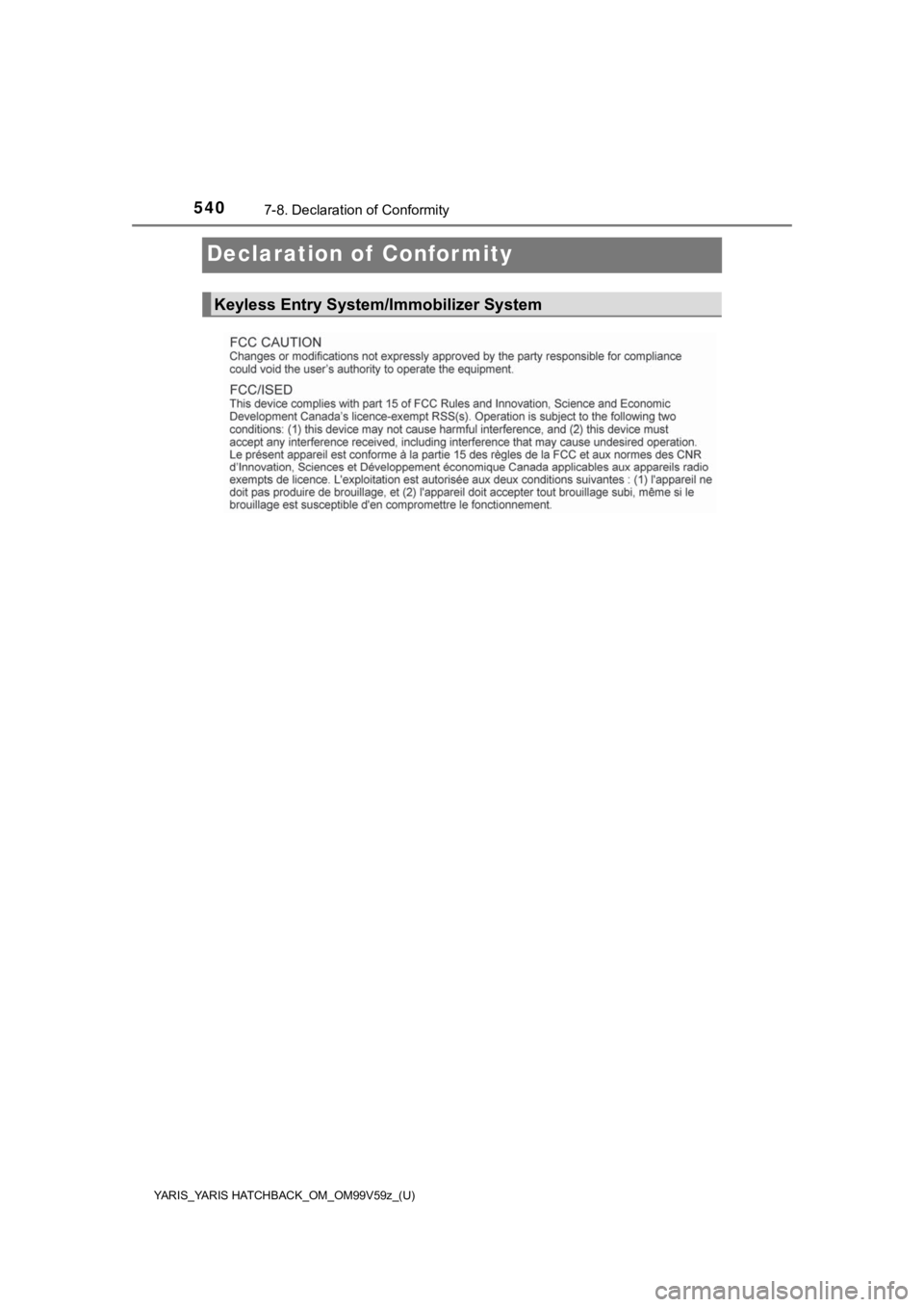
540
YARIS_YARIS HATCHBACK_OM_OM99V59z_(U)
7-8. Declaration of Conformity
Declaration of Conformity
Keyless Entry System/Immobilizer System